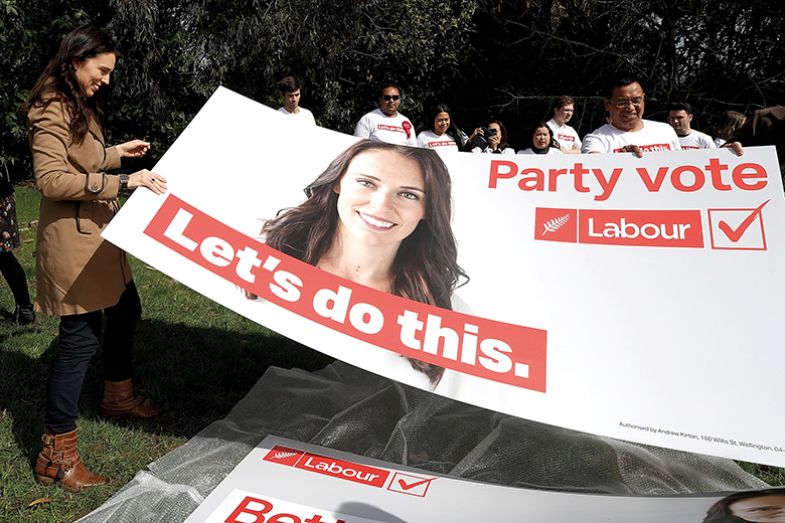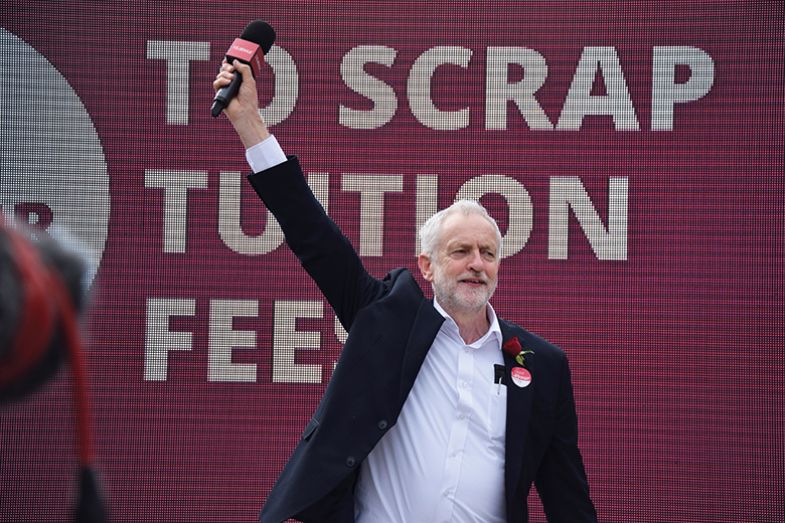New Zealand prime minister Jacinda Ardern has challenged plenty of conventions since her unlikely general election victory last September.
She became Labour Party leader only in August, after her predecessor, Andrew Little, resigned amid disastrous polling for the party. Yet she successfully led to victory a ragtag coalition that also contained the Greens and the populist New Zealand First party (whose leader had previously been deputy prime minister with her opponents), defeating a well-regarded National Party government presiding over a booming economy and close to full employment.
She went on to astonish an Australian journalist who rang her office to check on her name’s pronunciation by responding to his enquiry personally. She hammed it up in a satirical video about an international conspiracy to leave New Zealand off world maps, aimed at boosting tourism to the South Pacific outpost. And her pregnancy, revealed just three months into her new job, saw her become only the second elected head of government – after Pakistan’s Benazir Bhutto – to give birth while in office. Tough, engaging and unassuming, she has won admiration and affection across the island nation’s political spectrum.
But her opponents extend none of those warm feelings towards the reform platform that she campaigned on. And the item that kindles most outrage is her promise to eliminate tertiary education tuition fees.
That pledge is widely acknowledged to have helped swing the election. Much as the leader of the UK’s Labour Party, Jeremy Corbyn, did in last year’s general election, Ardern made it the centrepiece of her electioneering. In contrast, her opponent – the dependable but less charismatic Bill English – ran a frenetic campaign around multiple policies.
After winning the keys to Premier House, Ardern lost no time in fulfilling her promise, confirming that from this year, adults who have completed less than six months of post-school education will pay nothing for the first year of their tertiary courses. In addition, student living allowances and the amount that students can borrow on top of this to cover living expenses have both been raised by NZ$50 (£25.70) a week.
Nor will the giveaways to students end there. The plan is to progressively roll back tuition fees until, by 2024, New Zealanders will enjoy a full three years of free tuition, across all types of tertiary education institution.
While this all sounds like a young voter’s dream, the education minister, Chris Hipkins, says that it is much more than that. With automation and artificial intelligence reshaping occupations and supplanting traditional jobs, he says that more post-school training is paramount, and that abolishing fees is the way to open it up to the greatest possible number of people.
“Our needs from the education system have changed pretty dramatically,” he says. “The system hasn’t always been equipped to keep up with that change.”
Hipkins says that fees-free tertiary education is a natural extension of New Zealand’s move to free, compulsory secondary education in the 1940s.
“At the time, it was recognised that people needed to stay in the education system for longer. We’ve reached the point where there’s a general acknowledgement that secondary school education is no longer enough. We need to ensure that cost is not a barrier to people gaining the skills they need to be successful,” he says.

The Organisation for Economic Cooperation and Development’s Paris-based director of education and skills, Andreas Schleicher, agrees that universal tertiary education is a “credible” idea.
“In this century, tertiary education is probably going to be the entrance ticket [to the job market] for everyone,” he says. “Our data show that tax income from higher education in New Zealand is much larger than the tax expenditure [on it], so it can make sense. But the question is whether the government is going to live up to that promise [on fees-free tertiary education] in the long run – not just for a year or two.”
A key opposition gripe is that New Zealand taxpayers’ money is being used to bankroll something that people would have done anyway – and would have been prepared to pay for themselves. Thus, the entire population, including the disadvantaged, is subsidising a level of study that is traditionally dominated by the more well-off. But Hipkins dismisses such critiques as “economically illiterate” because “there’s a huge public good in having a more educated population. People who go to university earn higher incomes once they’ve completed their study, and therefore pay more taxes. It’s an investment in a higher tax take for the government. The more educated the population, the greater the tax take becomes if you have a progressive tax system – which New Zealand does.”
Representative body Universities New Zealand (UNZ) says that analyses of the country’s 1996 and 2013 censuses show that the proportion of jobs requiring degrees over that period rose from one-third to slightly over half. According to the body’s executive director, Chris Whelan, the 60,000 jobs that disappeared during that interval were in unskilled or semi-skilled occupations requiring less than a year’s training. “Of the 80,000 jobs that were created, the vast majority needed two to five years of qualifications or upskilling, whether through an apprenticeship or university degree,” he says.
As for fears that flooding the labour market with degrees could erode away the graduate premium and its associated higher tax take, Whelan says that while the number of degree holders grew by 90 per cent over the period in question, the graduate earnings premium dropped by just 11 per cent.
“We don’t have a supply-and-demand problem,” he says. “Whether that will still be the case in the future, we don’t know – but we do know that while we produce more graduates, the market is still demanding more and more skilled, educated people.”
Wellington-based education analyst Dave Guerin is more sceptical, however. He says that the demand for graduates is sustained primarily by the jobs market’s irrational addiction to credentials. “There are many jobs where a tertiary qualification is a filtering device” rather than a guarantee of a candidate’s possession of “a set of required skills”, says Guerin, editor of the Tertiary Insight industry newsletter. “Why do we need to hire a whole bunch of academics and ask people to go through years of tertiary education when we could just get a better filtering mechanism?”
Guerin scoffs at the idea of universal tertiary education, saying that many jobs in New Zealand and throughout the world simply do not need degree holders. And while he acknowledges the importance of so-called soft skills, he says that university is not necessarily the best place to cultivate them.
“Education is a good thing, but we shouldn’t see it as a solution for all problems,” he says, citing a review of New Zealand’s “youth guarantee” further education scheme for people who underperformed at school, which found little evidence of improved labour market outcomes for its participants.
“It’s useful to have people doing degrees, but once you start saying we should have 30 per cent more people in tertiary education, is that just a lobbying push by the tertiary education sector? Does the economy need that?”
In any case, higher education institutions are by no means offering full-throated support for Labour’s policy. Grant Guilford, vice-chancellor of Victoria University of Wellington, says that universities accept the government’s argument that there should not be a financial barrier to university entry: “We are very oriented towards accessibility.”
However, he worries that with government education policy focused on issues in schooling, early childhood education and vocational training, the issue of funding levels in universities – and their impact on quality – is not receiving enough attention.
“There’s no additional government assistance,” he says. “The [new] investment is being made in the students rather than the institutions. The downside is that, as autonomous organisations, you have to work a lot harder to get in revenue and invest in the quality of what you’re doing.”
Universities’ fears on this score were realised in Labour’s first budget, delivered in May. The party’s commitment of NZ$2.6 billion to deliver its initial pledges on allowances and fees left precious little for new allocations to either higher or vocational education.
“For the first time in two decades, universities in New Zealand will receive no real increase in government funding,” Paula Bennett, the shadow higher education minister, claimed at the time, citing estimates that this would cost individual universities up to NZ$10 million.
UNZ’s Whelan says that this could damage students’ experience and undermine other revenue streams. He also notes that New Zealand universities have fallen by scores of places in global rankings over the past decade, while student-to-staff ratios grew from 17.8 to 18.4 between 2006 and 2015.
“Like most world-class university systems, we depend extensively on being able to recruit staff and students from overseas. Things such as rankings, staff ratios, the student experience – they’re very important factors,” he says.
But Hipkins points out that government bankrolling of tuition fees is just another form of public funding. “Ultimately, it’s money that ends up in [universities’] bank accounts,” he says.
And Guerin says that universities pocketed a cash-flow advantage from the switch to free fees because they received government advances several months earlier than they would have done under the old regime. And while the budget funding freeze still might hurt universities “at the margins”, the extra living allowances could free students from having to earn so much money on the side, permitting them to pay more attention to their studies.

The OECD’s Schleicher points out that there is no such thing as free higher education: “Someone’s got to pay for it. The question is always: how do you share the costs and benefits between individuals and society?”
In his analysis, there are four Western responses to that question. Scandinavia has very low or non-existent fees alongside high investment; the rest of continental Europe also has low fees, but “not so much public money”; England, Australia and New Zealand have higher fees and income-contingent study loans; while countries such as the US, South Korea and Japan also charge higher fees and impose the “full burden” of commercial loans on students.
Schleicher says that the Nordic model works well because high participation rates minimise the “middle-class welfare” objection to free tuition, while the anglophone income-contingent loan system secures both “risk-free access to higher education and good quality”.
He is less impressed with the mainstream European model, whereby “everybody says higher education is important, but taxpayers aren’t willing to make the investment. Institutions are not allowed to charge tuition [fees] and, in the end, students suffer.” Either that or, as in France’s grandes écoles, “access becomes socially selective because you have only a few places. It’s the wealthy, not the brightest, who get those places.”
New Zealand risks inheriting similar problems, he says. “If you want to make higher education free, you have to put up the money to do it well. Otherwise a system of income-contingent loans or means-tested grants is quite a fair way of financing [high-quality higher] education.”
The National Party’s Bennett does not dispute the need for a skills boost in the workforce: “We keep hearing that we need more nurses, builders and teachers.” But her beef with Labour’s fees-free policy is that it is “badly targeted”. Despite its introduction, “what we are hearing from the sector is that they haven’t seen a marked increase in student numbers or apprenticeships”. This was confirmed in recent official figures, which show that , as of April, enrolments to universities are up by just 0.3 per cent year-on-year, while enrolments to polytechnics are down by 2.6 per cent.
Guilford’s suspicion is that the many employment opportunities offered to potential students by a country with an unemployment rate below 5 per cent has “swamped” any “beneficial effect” of the fees-free policy in its first year.
But Hipkins says that the government never expected a big bump in enrolments. “We introduced the fees-free package very late in the year – we only confirmed it just before Christmas. A lot of people had already made their decisions about what they were doing this year [by then]. We may see a bigger impact on enrolments next year as the new scheme beds in.”
He adds that enrolment patterns have “peaks and troughs”, particularly in the polytechnic sector. “It’s very early days,” he says. “The data’s still being crunched. It’s amazing how long it takes to get reliable data.”
That lack of timely data has had an upside. In June, the government revealed that it had overestimated the number of people eligible for fees-free tertiary study. This allowed it to redistribute its budget , relaxing the borrowing limits imposed on medicine, dentistry, optometry and veterinary science students. More significantly, it agreed to raise tertiary institutions’ tuition subsidies by 1.6 per cent in 2019 – something that Hipkins says will “help address some of the pressures faced by the sector”.
But Whelan says that universities will still be worse off over the next 12 months in real terms. He says that while New Zealand’s consumer price index is running at about 1.1 per cent, universities’ costs are increasing at 3 or 4 per cent because of the outlay on salaries, construction, scientific equipment and journal licensing, all of which are excluded from the CPI.

But while university deficits potentially rise, some students are enjoying a debt holiday. In the first quarter of 2018, 25,400 fewer borrowed to pay fees than had done in the same period of 2017, saving themselves a combined NZ$151 million. This has helped them to dodge one of the most punitive student debt repayment regimes in the world.
New Zealand graduates must repay their student borrowings at a flat rate of 12 per cent a year for every dollar earned above a threshold of just NZ$19,448, or about £10,000. By comparison, graduates of English universities currently repay at a rate of 9 per cent beyond a salary threshold to be raised from £21,000 to £25,000 in 2018-19 (although debt levels accrue at 3 percentage points above the retail price index). And despite recent tightening of the conditions, Australian graduates still do not have to begin repaying until their earnings reach a comparatively healthy A$51,957 (£29,110), and even then they pay just 2 per cent of the excess income. They do not hit the full repayment rate of 8 per cent until their earnings climb to A$103,766: about 27 per cent more than average earnings.
Kiwi borrowers, on the other hand, see a large chunk of their income accounted for by student debt repayment even when they are earning substantially less than the minimum wage. Hipkins says that this puts a “huge burden” on people moving into their adult lives and facing an increasingly prohibitive housing market.
How did New Zealand’s repayment rates get to be so onerous? Guerin blames another Labour policy: the 2005 decision by Helen Clark, then the prime minister, to reduce interest on student loans from about 7 per cent to nothing at all – not even indexation to maintain the debts’ real value. This, he says, has put a straitjacket on subsequent tertiary education policy, thwarting any move that might have raised overall lending because the government knows that it will immediately have to write off more than 40 per cent of the money it lends owing to the inflationary loss in its value.
According to Guerin, the subsequent National government did not want to change the zero-interest approach, so instead it tightened loans and allowances as much as it could without triggering a voter backlash. It increased the repayment rate from 10 per cent to 12 per cent and froze the repayment threshold, which has remained near its current rate for almost a decade.
On the plus side, zero-interest has made it cheaper than it otherwise would have been for Ardern to eliminate tuition fees. While the cost of this grand venture was projected at between NZ$342 million and NZ$628 million a year over the initial five years, the government has calculated that it will reap an estimated NZ$434 million in trade-off savings because it will be bankrolling fewer loans of declining value.
But the repayment terms have also discouraged the government from freeing up university places to meet student demand, or giving universities more discretion in the fees they charge. Tuition fees have in essence been freeze-framed, with universities not allowed to alter what they charged 13 years ago beyond small annual increases.
In Guerin’s view, zero-interest loans is bad policy. “But policy and reality sort of divorced themselves a long time ago in student loans. It’s driven by politics. It’s based on what politicians think they can sell to the public.”
He says that Labour could conceivably have sold to the public the idea of indexing student debts to the consumer price index to maintain their real value, removing higher education policy from its straitjacket and potentially seeing more money flowing into universities. He laments that, instead, the party chose to take on the much greater “deadweight cost” of its fee-free policy.
“We’re giving money to people who were doing much the same thing before we gave them money,” he says. “If we were going to spend hundreds of millions of dollars on tertiary education, I could come up with 10 better ideas. If you wanted to increase participation from people with lower incomes, you’d be much better off spending money on supporting academic achievement at school and providing pathway programmes to help familiarise them with the social and cultural environment of higher education.”

Whether the fees-free policy endures is open to question. Ardern leads a minority coalition government, meaning that her grip on power is not particularly strong. But in a populist, post-austerity era, the political temptation to abolish tuition fees is strong. In England, the Conservative government reacted to the perceived electoral popularity of Corbyn’s pledge to abolish fees by easing loan repayment terms and announcing a review of higher education finance. And in the US, various states have responded to a pledge by the Democratic presidential candidate Bernie Sanders – later largely adopted by Hillary Clinton – to make tuition free at public universities. New York’s governor, Andrew Cuomo, led the way last year, signing a bill abolishing tuition fees for in-state students whose families earn up to $125,000 (£95,000) a year.
The politics of going into an election promising to reimpose thousands of dollars of debt on young people is certainly problematic, and Bennett says that the National Party has not yet decided what it would do if it were to win New Zealand’s next national vote – which will be held by November 2020 at the latest. Nevertheless, she concedes that it is unlikely that the money that Labour has earmarked to pay for the abolition of fees will remain “completely untouched” by the Nationals.
“There’s no point getting more students into tertiary education if the institutions aren’t even funded enough to stay afloat,” she says, “let alone provide quality education in keeping with international standards.”
POSTSCRIPT:
Print headline: No fees!
Register to continue
Why register?
- Registration is free and only takes a moment
- Once registered, you can read 3 articles a month
- Sign up for our newsletter
Subscribe
Or subscribe for unlimited access to:
- Unlimited access to news, views, insights & reviews
- Digital editions
- Digital access to THE’s university and college rankings analysis
Already registered or a current subscriber?








